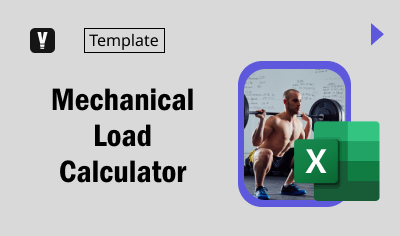18 de June de 2025
Top 5 Mistakes Athletes Make with Load Management (And How to Fix Them)
Regarding athletic performance, mastering load management is essential for achieving optimal results and preventing injuries. Yet, many athletes and coaches struggle to appropriately balance training loads, leading to poor performance outcomes and elevated injury risks.
Understanding the common mistakes associated with load management and knowing how to correct them can make all the difference in an athlete’s training cycle. This post outlines five key mistakes athletes make with load management and offers actionable ways to fix them, utilizing tools like the Mechanical Load Calculator to streamline and optimize training strategies.
What Is Load Management, and Why Does It Matter?
Load management refers to the process of monitoring and adjusting the amount of physical stress placed on an athlete during training. It takes into account a mix of volume, intensity, and frequency to develop a balanced and efficient training plan tailored to the athlete’s needs. Proper load management safeguards performance improvements while reducing the risk of overtraining or plateauing. Despite its importance, some pervasive mistakes can derail an athlete’s progress.

Mechanical Load Calculator
Mistake 1: Underloading, Not Providing Enough Stimulus
Athletes often underestimate how much workload is necessary for improvement. While staying too conservative might seem like a safe strategy, chronic underloading can result in stagnation, as the athlete’s body lacks the adequate stimulus needed for adaptation.
Why It’s a Problem:
- Failing to challenge the athlete’s capabilities leads to limited progress in strength, speed, or endurance.
- Underloading can also reduce confidence in the athlete’s ability to meet competitive demands.
The Fix:
Use tools like the Mechanical Load Calculator to determine the correct workload for each session. By evaluating factors such as the athlete’s current fitness level, workload history, and phase of training, the calculator ensures that the training provides just the right amount of challenge—enough to stimulate growth without risking overexertion.
Pro Tip: Track progression weekly and adjust workloads incrementally (e.g., adding 5-10% volume) to maintain an upward trend in performance.
Mistake 2: Overtraining, Ignoring Recovery Needs
On the flip side, overtraining is a widespread mistake, especially among highly motivated athletes. When the desire to improve leads to pushing beyond healthy limits, it often results in fatigue, injury, or burnout.
Why It’s a Problem:
- Overtraining leads to chronic fatigue, weaker performance, and reduced immunity to illness.
- It creates a higher likelihood of overuse injuries that may lead to prolonged recovery periods.

Mechanical Load Calculator
The Fix:
Integrate proactive recovery strategies into load management. Ensure athletes have sufficient rest days built into their programs and utilize periodized training cycles to balance work and recovery.
Leverage the Mechanical Load Calculator to monitor training load trends, enabling you to spot periods of excessive volume or intensity before they cause harm. Programs that alternate between high-load and low-load weeks can be especially effective for long-term sustainability.
Pro Tip: Consider using objective recovery metrics such as heart rate variability (HRV) or self-reported measures of fatigue to assess recovery readiness.
Mistake 3: Inconsistent Tracking of Training Load
Many athletes and coaches fail to consistently track training loads, creating gaps in the data necessary for evaluating progress. Without accurate tracking, it’s impossible to make informed adjustments.
Why It’s a Problem:
- Lack of consistent data makes it harder to detect trends in performance fluctuations.
- It increases the risk of both underloading and overtraining due to a lack of visibility over workload distribution.
The Fix:
Use a centralized system like the Mechanical Load Calculator to log all workload data. This includes both internal load (e.g., perceived effort levels) and external load (e.g., volume, reps, intensity). By consolidating data in one place, you can easily monitor trends over time and identify when adjustments are necessary.
Pro Tip: Make training load tracking part of the daily routine. Assign a consistent time—such as after each session—for updating the training log.
Mistake 4: Neglecting Individualization in Load Management
A one-size-fits-all approach to load management is rarely effective. Athletes vary significantly in terms of physiology, fitness level, recovery capacity, and goals. Applying the same load parameters across the board disregards these differences.
Why It’s a Problem:
- Training programs that fail to account for individual variation may overwork some athletes while underworking others.
- Generalized plans reduce the precision and effectiveness of training outcomes.
The Fix:
Tailor workloads for individual athletes using the Mechanical Load Calculator. By analyzing each athlete’s unique performance metrics (e.g., speed, endurance, power output), this tool can help create truly personalized training programs.
Pro Tip: Regularly reassess individual progress by conducting periodic benchmark tests, such as 1-rep max lifts or timed sprints, to ensure the load parameters remain relevant.
Mistake 5: Overlooking Tapering Before Competition
Tapering, reducing training volume before important competitions, often gets overlooked by athletes who feel they must “do more” to prepare. However, pushing too hard during the lead-up to competition dramatically increases the risk of fatigue on game day.
Why It’s a Problem:
- Fatigue can overshadow fitness gains, resulting in suboptimal performance when it matters most.
- Lack of tapering can also leave athletes feeling mentally drained and less focused during competition.
The Fix:
Design a tapering period into the training cycle using calculated reductions in workload. The Mechanical Load Calculator can assist by suggesting scientifically backed tapering plans based on the athlete’s recent workloads. A typical taper begins 7-14 days before competition, with a 30-50% reduction in training volume while intensity remains high.
Pro Tip: Monitor the athlete’s perceived readiness during the taper to ensure they feel both physically and mentally prepared to perform at their peak.
How the Mechanical Load Calculator Can Help You Avoid These Mistakes
Load management doesn’t have to feel overwhelming. With tools like the Mechanical Load Calculator, athletes and coaches have access to reliable, data-driven suggestions for optimizing training loads. This tool provides:
- Accurate assessments of workload requirements based on individual progress.
- Clear guidance for achieving the perfect balance between work and recovery.
- Real-time recommendations for reducing injury risk and promoting consistency.
Whether you’re coaching elite athletes or supporting high school competitors, using a load management tool can streamline your decision-making and ensure optimal outcomes for every training session.
Take Control of Load Management Today
Athletes deserve training programs that maximize performance while minimizing risks. By understanding and correcting these five common mistakes, underloading, overtraining, inconsistent tracking, lack of individualization, and poor tapering, you can create a foundation for success. Want to simplify and optimize your load management process?
Download the Mechanical Load Calculator today and take the guesswork out of tailoring training programs to meet your athletes’ needs.
